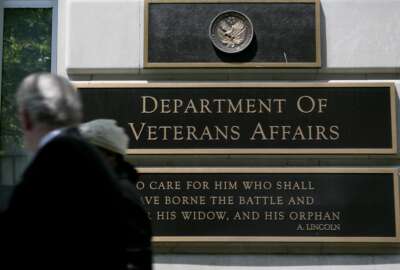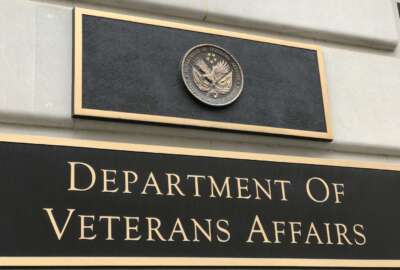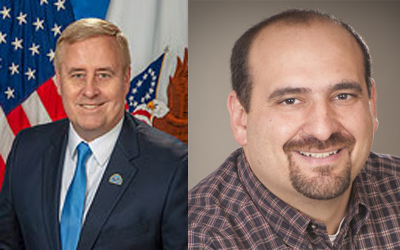
VA extending pandemic IT mindset to continue modernization acceleration
The Department of Veterans Affairs is implementing a portfolio management approach to managing technology and business outcomes.
The Department of Veterans Affairs is reaching a turning point in how it manages its technology and services.
VA is taking its urgent, no-fail mindset from the pandemic and instilling it across every part of its technology infrastructure.

“Our motto was, basically, ‘let’s stay ahead of demand no matter what the demand was.’ If it was the telehealth visit issue, we want to make sure that we had, no matter what the circumstances were, sufficient bandwidth to support this rapidly growing demand on the infrastructure. The cloud helped. The infrastructure upgrades helped,” said Paul Brubaker, the acting principal deputy assistant secretary (PDAS) for information and technology and deputy chief information officer at the VA, during a media roundtable on Sept. 23, which played on Ask the CIO. “Keep in mind during April to June, we on boarded 96,000 new employees to help support our COVID response. These are contractors and new VA employees, and we had to provision them. I recall, I forget the exact number of nurses, but it was well over 100 that were going to show up in Chicago over the weekend. We found out about it Tuesday or Wednesday, and we were able to get those devices provisioned and get them productive day one.”
Brubaker said VA’s motto extended to not just typical technology challenges, but to extraordinary events such as when Baylor University offered up a hospital to the agency for COVID infected veterans.
He said VA OI&T got the hospital equipped with network connections and other technologies in a matter of weeks instead of three months or more.
“It was nothing short of magical how everybody came together. If you don’t think that government agencies can be flexible and agile and rapidly deploy, this is a prime use case that we should be able to disabuse you of that notion,” he said. “We were able to accelerate the plans that we had for digital transformation by at least two years by living through this pandemic. I think we did a pretty admirable job of staying ahead of demand and responding so that when anybody turned on a switch they had the signal, were able to move the ones and zeros that they needed to accomplish the mission. And it wasn’t just about accomplishing the mission, but it was really about measurably improving our mission and operational performance as a result of this pandemic. So it’s really a good news story.”
Brubaker said what the pandemic proved, once again, is the importance of tying the IT investments to outcomes. Brubaker, who helped write the Clinger-Cohen Act when he worked for then-Sen. William Cohen (R-Maine), said all the work around IT investment management and capital planning and investment processes always comes back to ensuring mission effectiveness.
A flexible portfolio approach
One way VA is doing that is through a portfolio management approach.
“We kicked off [on Sept. 22] our enterprise supply chain portfolio, where we’re assessing our current state environment because I think it’s really critical for us to succeed as an organization to really understand the workflows, the business process reengineering that takes place and how we apply that technology,” Brubaker said. “Now, that’s not to say that we’re not going to be burdened by some overly bureaucratic process that was invented 20 years ago. I think we’ve got some approaches that we’ve built into our thinking and our strategy that will allow us to be pretty agile, to accommodate near term investments and new technologies.”
Given the federal budgeting cycle and the rapid changes in technology, he added the portfolio management approach must be flexible to accommodate expected, but unknown changes in both technology and mission requirements.
One example of that agility that Brubaker was talking about came during the early part of the pandemic when veterans and their caregivers overwhelmed the Veterans Health Administration’s call centers with questions.
Charles Worthington, the VA chief technology officer, said in addition to upgrading the call center, OI&T worked with VHA to develop a chatbot, the first one in the agency, to handle some of the most common questions.
“That went from an idea to something that was put into production in about five weeks, and so far that chatbot has answered over 140,000 questions. Every time we can save a phone call that frees up the staff to help somebody with a more complicated problem,” Worthington said. “Another one of my favorite examples of the whole response was as the VHA facilities were trying to figure out how to operate safely at the height of the pandemic. They were asking screening questions — and still do — at the front door for people to come in and just making sure that if anyone’s feeling symptoms that they’re brought to a place where they can be further screened, further assessed. Obviously, for our VHA staff that are coming and going from these facilities every day, that was becoming a pretty burdensome process to have to wait in this line and answer the same questions. One of our local medical centers identified that this is a good problem that software could have solved and built a little tool that let their employees answer the screening questions and just flash their phone. We heard about that, quickly grabbed it, kick the tires on it and scaled it to be something that the entire VA could use. That one went from this pilot that a medical center had created to an actual live application that every medical center could use with the screening questions that had been kind of vetted through the formal VA main COVID-19 Task Force, and was deployed to the whole field. That screening tool has been used over 17 million times now.”
133 apps to the cloud
Part of the reason for VA’s ability to be agile comes from the work its done over the last few years in moving to the cloud and modernizing its technology.
Dr. Neil Evans, the chief officer for Connected Care and who is performing the delegable duties of the Assistant Secretary for Information and Technology and acting CIO, told House lawmakers on Sept. 30 that VA has reduced its technical debt by 10% across its common core technologies, including end user devices, internet bandwidth and communication capabilities, since 2019.
Todd Simpson, the deputy assistant secretary of DevSecOps at VA, said at the press conference that the move to the cloud has increased VA’s agility and security and helped them focus on mission outcomes.
“We’ve moved 133 applications to the cloud; we have 82 in progress. There’s roughly 400 in house developed apps still floating around out there, but we’ve reduced our custom development from 57% in 2019 to 45% in 2021,” Simpson said. “We continue to move toward that model, where I think we’re getting that security inheritance through the software-as-a-service products and through the commercial-off-the-shelf (COTS) products and through the cloud.”
Copyright © 2025 Federal News Network. All rights reserved. This website is not intended for users located within the European Economic Area.
Jason Miller is executive editor of Federal News Network and directs news coverage on the people, policy and programs of the federal government.
Follow @jmillerWFED
Related Stories

Cloud Exchange: VA leaning on cloud services to accelerate application modernization






